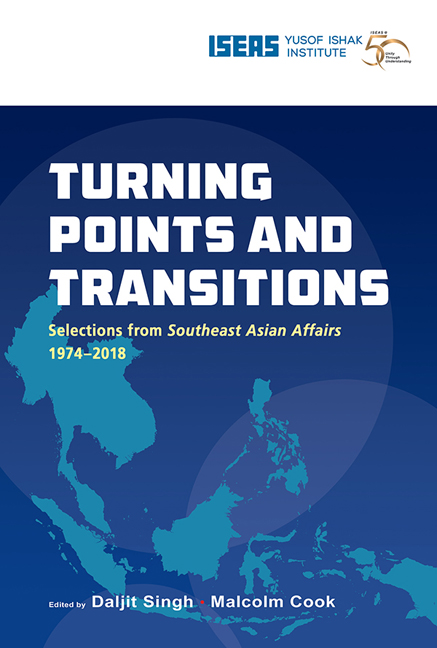Book contents
- Frontmatter
- Contents
- Message from the Director
- Foreword
- Foreword
- Introduction
- THE REGION
- BRUNEI
- CAMBODIA
- INDONESIA
- LAOS
- MALAYSIA
- MYANMAR
- THE PHILIPPINES
- SINGAPORE
- THAILAND
- VIETNAM
- Vietnam in Perspective (1975)
- Year One of Postcolonial Vietnam (1977)
- Vietnam, ASEAN and the Indochina Refugee Crisis (1980)
- Vietnam and ASEAN: A First Anniversary Assessment (1997)
Year One of Postcolonial Vietnam (1977)
from VIETNAM
Published online by Cambridge University Press: 29 May 2019
- Frontmatter
- Contents
- Message from the Director
- Foreword
- Foreword
- Introduction
- THE REGION
- BRUNEI
- CAMBODIA
- INDONESIA
- LAOS
- MALAYSIA
- MYANMAR
- THE PHILIPPINES
- SINGAPORE
- THAILAND
- VIETNAM
- Vietnam in Perspective (1975)
- Year One of Postcolonial Vietnam (1977)
- Vietnam, ASEAN and the Indochina Refugee Crisis (1980)
- Vietnam and ASEAN: A First Anniversary Assessment (1997)
Summary
The year 1976 for Vietnam was the first since 1858 — a total of 117 years — that the country was entirely free of Western colonial intervention. During this first year of independence, the country had to face a multifaceted challenge: that of bringing back national unity (disrupted since 1862), repairing the massive physical destruction, and overcoming the economic, cultural and social dislocations that had occurred during the Thirty-Year War (1945–75). Beyond these immediate problems, the first year of peace was also one when the foundations were laid for the country's future ideological, economic and institutional structure and for its selfassertion in international affairs. In more specific terms, 1976 was a year of hectic transitional activities which included the administrative restructuring of the country, nationwide elections for a National Assembly of the reintegrated country, a new formal name for the country (“The Socialist Republic of Vietnam”), and planned industrial and agricultural transformations designed to give the country a foundation for rapid economic and social development.
This article attempts to review the principal aspects of Vietnam's public life during 1976. This is done while recognizing the hazards of such an undertaking. Aside from the risks inherent in “instant history” — in effecting from afar a year-end review of the development process of any society — there are special problems awaiting those who study contemporary Vietnam. Most of these problems are associated with the fact that Vietnam, unlike other societies, is a divided country in the process of becoming one. While it is true that formally and juridically the country was reintegrated on the State plane during 1976, due to long years of partition and especially the difference in the socio-political regimes that governed the two regions, the reality of the existence of the two zones remains vivid. This could be observed in the postwar reconstruction efforts and in the transformations of the social, economic and institutional aspects of each zone. The North, as we shall see momentarily, greatly suffered from the war in material terms (far more than the South in many ways, due to the massive terroristic bombings); yet, it has the advantage of a stable political, social and economic structure and an experienced leadership.
- Type
- Chapter
- Information
- Turning Points and TransitionsSelections from Southeast Asian Affairs 1974-2018, pp. 723 - 737Publisher: ISEAS–Yusof Ishak InstitutePrint publication year: 2018

